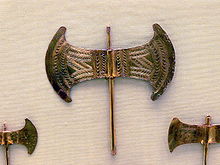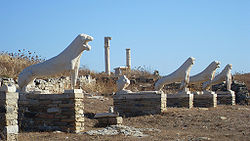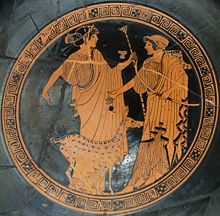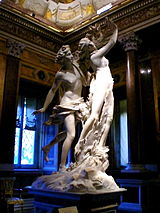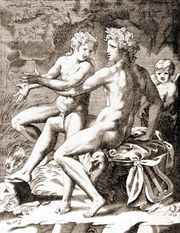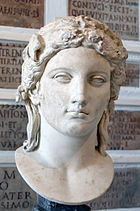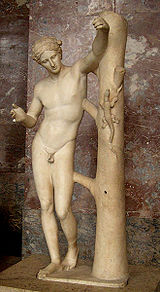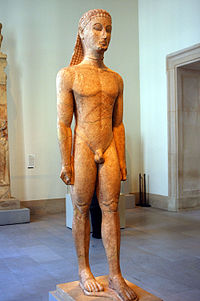- Apollo
-
This article is about the Greek and Roman god. For other uses, see Apollo (disambiguation) and Phoebus (disambiguation).Not to be confused with Phobos (mythology).
Apollo 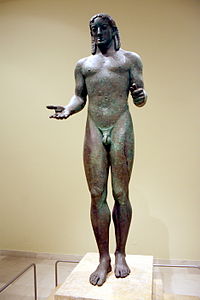
Piraeus Apollo.Archaic-type bronze (530-520 BC), one of the very few surviving. Archaeological Museum of Piraeus (Athens).God of music, poetry, plague, oracles, sun, medicine, light and knowledge Abode Mount Olympus Symbol Lyre, laurel wreath, python, raven, bow and arrows Parents Zeus and Leto Siblings Artemis Children Asclepius, Troilus, Aristaeus, Orpheus Roman equivalent Apollo  Features
Features- Hubris · Reciprocity · Virtue
Doctrines- Mythology · Orthopraxy · Polytheism
Practices- Amphidromia · Animal sacrifice · Iatromantis · Pharmakos · Temples · Votive Offerings
Deities- Twelve Olympians:
Aphrodite · Apollo · Ares · Artemis · Athena · Demeter · Dionysus · Hades · Hephaestus · Hera · Hermes · Hestia · Poseidon · Zeus
---
Primordial deities:
Aether · Chaos · Cronus · Erebus · Gaia · Hemera · Nyx · Tartarus · Uranus
---
Lesser gods:
Eros · Hebe · Hecate · Helios · Herakles · Iris · Nike · Pan · Selene
Texts- Argonautica · Bibliotheca · Iliad · Odyssey · Theogony · Works and Days
Apollo (Attic, Ionic, and Homeric Greek: Ἀπόλλων, Apollōn (gen.: Ἀπόλλωνος); Doric: Ἀπέλλων, Apellōn; Arcadocypriot: Ἀπείλων, Apeilōn; Aeolic: Ἄπλουν, Aploun; Latin: Apollō) is one of the most important and complex of the Olympian deities in Greek and Roman mythology. The ideal of the kouros (a beardless, athletic youth), Apollo has been variously recognized as a god of light and the sun, truth and prophecy, medicine, healing, plague, music, poetry, arts, archery, and more. Apollo is the son of Zeus and Leto, and has a twin sister, the chaste huntress Artemis. Apollo is known in Greek-influenced Etruscan mythology as Apulu. Apollo was worshiped in both ancient Greek and Roman religion, and in the modern Greco–Roman Neopaganism.
As the patron of Delphi (Pythian Apollo), Apollo was an oracular god—the prophetic deity of the Delphic Oracle. Medicine and healing were associated with Apollo, whether through the god himself or mediated through his son Asclepius, yet Apollo was also seen as a god who could bring ill-health and deadly plague. Amongst the god's custodial charges, Apollo became associated with dominion over colonists, and as the patron defender of herds and flocks. As the leader of the Muses (Apollon Musegetes) and director of their choir, Apollo functioned as the patron god of music and poetry. Hermes created the lyre for him, and the instrument became a common attribute of Apollo. Hymns sung to Apollo were called paeans.
In Hellenistic times, especially during the 3rd century BCE, as Apollo Helios he became identified among Greeks with Helios, Titan god of the sun, and his sister Artemis similarly equated with Selene, Titan goddess of the moon.[1] In Latin texts, on the other hand, Joseph Fontenrose declared himself unable to find any conflation of Apollo with Sol among the Augustan poets of the 1st century, not even in the conjurations of Aeneas and Latinus in Aeneid XII (161–215).[2] Apollo and Helios/Sol remained separate beings in literary and mythological texts until the 3rd century CE.
Contents
Etymology
The etymology of Apollo is uncertain. The spelling Ἀπόλλων had almost superseded all other forms by the beginning of the common era, but the Doric form Απέλλων is more archaic, derived from an earlier *Απέλjων. The name is certainly cognate with the Doric month name Απέλλαιος and the Doric festival απελλαι.[3]
Several instances of popular etymology are attested from ancient authors. Thus, the Greeks most often associated Apollo's name with the Greek verb ἀπόλλυμι (apollymi), "to destroy".[4] Plato in Cratylus connects the name with ἀπόλυσις (apolysis), "redeem", with ἀπόλουσις (apolousis), "purification", and with ἁπλοῦν (aploun), "simple",[5] in particular in reference to the Thessalian form of the name, Ἄπλουν, and finally with Ἀει-βάλλων (aeiballon), "ever-shooting". Hesychius connects the name Apollo with the Doric απέλλα (apella), which means "assembly", so that Apollo would be the god of political life, and he also gives the explanation σηκός (sekos), "fold", in which case Apollo would be the god of flocks and herds.
Following the tradition of these Ancient Greek folk etymologies, in the Doric dialect the word απέλλα originally meant wall, fence from animals and later assembly within the agora. In the Ancient Macedonian language πέλλα (pella) means stone, and some toponyms are derived from this word: Πέλλα (Pella:capital of Ancient Macedonia), Πελλήνη (Pellini-Pallini).
A number of non-Greek etymologies have been suggested for the name,[6] The form Apaliunas (dx-ap-pa-li-u-na-aš) is attested as a god of Wilusa[7] in a treaty between Alaksandu of Wilusa and the Hittite great king Muwatalli II ca 1280 BCE.Alaksandu could be Paris-Alexander of Ilion",[8] whose name is Greek.[9] The Hittite testimony reflects an early form *Apeljōn, which may also be surmised from comparison of Cypriot Απειλων with Doric Απελλων.[10] A Luwian etymology suggested for Apaliunas makes Apollo "The One of Entrapment", perhaps in the sense of "Hunter".[11]
Among the proposed etymologies is the Hurrian and Hittite divinity, Aplu, who was widely invoked during the "plague years". Aplu, it is suggested, comes from the Akkadian Aplu Enlil, meaning "the son of Enlil", a title that was given to the god Nergal, who was linked to Shamash, Babylonian god of the sun.[12]
Greco-Roman epithets
Apollo, like other Greek deities, had a number of epithets applied to him, reflecting the variety of roles, duties, and aspects ascribed to the god. However, while Apollo has a great number of appellations in Greek myth, only a few occur in Latin literature, chief among them Phoebus (
 /ˈfiːbəs/ fee-bəs; Φοίβος, Phoibos, literally "radiant"), which was very commonly used by both the Greeks and Romans in Apollo's role as the god of light.
/ˈfiːbəs/ fee-bəs; Φοίβος, Phoibos, literally "radiant"), which was very commonly used by both the Greeks and Romans in Apollo's role as the god of light.As sun-god and god of light, Apollo was also known by the epithets Aegletes (/əˈɡliːtiːz/ ə-glee-teez; Αἰγλήτης, Aiglētēs, from αἴγλη, "light of the sun"),[13] Helius (/ˈhiːliəs/ hee-lee-əs; Ἥλιος, Helios, literally "sun"),[14] Phanaeus (/fəˈniːəs/ fə-nee-əs; Φαναῖος, Phanaios, literally "giving or bringing light"), and Lyceus (/laɪˈsiːəs/ ly-see-əs; Λύκειος, Lukeios, from Proto-Greek *λύκη, "light"). The meaning of the epithet "Lyceus" later became associated Apollo's mother Leto, who was the patron goddes of Lycia (Λυκία) and who was identified with the wolf (λύκος),[15] earning him the epithets Lycegenes (/laɪˈsɛdʒəniːz/ ly-sej-ə-neez; Λυκηγενής, Lukēgenēs, literally "born of a wolf" or "born of Lycia") and Lycoctonus (/laɪˈkɒktənəs/ ly-kok-tə-nəs; Λυκοκτόνος, Lukoktonos, from λύκος, "wolf", and κτείνειν, "to kill"). As god of the sun, the Romans referred to Apollo as Sol (/ˈsɒl/ sol; literally "sun" in Latin).
In association with his birthplace, Mount Cynthus on the island of Delos, Apollo was called Cynthius (/ˈsɪnθiəs/ sin-thee-əs; Κύνθιος, Kunthios, literally "Cynthian"), Cynthogenes (/sɪnˈθɒdʒɨniːz/ sin-thoj-i-neez; Κύνθογενης, Kunthogenēs, literally "born of Cynthus"), and Delius (/ˈdiːliəs/ dee-lee-əs; Δήλιος, Delios, literally "Delian"). As Artemis's twin, Apollo had the epithet Didymaeus (/dɪdɨˈmiːəs/ did-i-mee-əs; Διδυμαιος, Didumaios, from δίδυμος, "twin").
 Partial view of the temple of Apollo Epikurios (healer) at Bassae in southern Greece
Partial view of the temple of Apollo Epikurios (healer) at Bassae in southern Greece
Apollo was worshipped as Actiacus (/ækˈtaɪ.əkəs/ ak-ty-ə-kəs; Ἄκτιακός, Aktiakos, literally "Actian"), Delphinius (/dɛlˈfɪniəs/ del-fin-ee-əs; Δελφίνιος, Delphinios, literally "Delphic"), and Pythius (/ˈpɪθiəs/ pith-ee-əs; Πύθιος, Puthios, from Πυθώ, Pūthō, the area around Delphi), after Actium (Ἄκτιον) and Delphi (Δελφοί) respectively, two of his principal places of worship.[16][17] An etiology in the Homeric hymns associated the epithet "Delphinius" with dolphins. He was worshipped as Acraephius (/əˈkriːfiəs/ ə-kree-fee-əs; Ἀκραιφιος, Akraiphios, literally "Acraephian") or Acraephiaeus (/əˌkriːfiˈiːəs/ ə-kree-fee-ee-əs; Ἀκραιφιαίος, Akraiphiaios, literally "Acraephian") in the Boeotian town of Acraephia (Ἀκραιφία), reputedly founded by his son Acraepheus; and as Smintheus (/ˈsmɪnθjuːs/ smin-thews; Σμινθεύς, Smintheus, "Sminthian"—that is, "of the town of Sminthos or Sminthe")[18] near the Troad town of Hamaxitus. The epithet "Smintheus" has historically been confused with σμίνθος, "mouse", in association with Apollo's role as a god of disease. For this he was also known as Parnopius (/pɑrˈnoʊpiəs/ par-noh-pee-əs; Παρνόπιος, Parnopios, from πάρνοψ, "locust") and to the Romans as Culicarius (/ˌkjuːlɨˈkæriəs/ kew-li-karr-ee-əs; from Latin culicārius, "of midges").
 Temple of the Delians at Delos, dedicated to Apollo (478 BC). 19th-century pen-and-wash restoration
Temple of the Delians at Delos, dedicated to Apollo (478 BC). 19th-century pen-and-wash restoration
 Temple of Apollo Smintheus at Çanakkale, Turkey
Temple of Apollo Smintheus at Çanakkale, Turkey
In Apollo's role as a healer, his appellations included Acesius (/əˈsiːʒəs/ ə-see-zhəs; Ἀκέσιος, Akesios, from ἄκεσις, "healing"), Acestor (/əˈsɛstər/ ə-ses-tər; Ἀκέστωρ, Akestōr, literally "healer"), Paean (/ˈpiːən/ pee-ən; Παιάν, Paiān, from παίειν, "to touch"), and Iatrus (/aɪˈætrəs/ eye-at-rəs; Ἰατρός, Iātros, literally "physician").[19] Acesius was the epithet of Apollo worshipped in Elis, where he had a temple in the agora.[20] The Romans referred to Apollo as Medicus (/ˈmɛdɨkəs/ med-i-kəs; literally "physician" in Latin) in this respect. A temple was dedicated to Apollo Medicus at Rome, probably next to the temple of Bellona.
As a protector and founder, Apollo had the epithets Alexicacus (/əˌlɛksɨˈkeɪkəs/ ə-lek-si-kay-kəs; Ἀλεξίκακος, Alexikakos, literally "warding off evil"), Apotropaeus (/əˌpɒtrəˈpiːəs/ ə-pot-rə-pee-əs; Ἀποτρόπαιος, Apotropaios, from ὰποτρέπειν, "to avert"), and Epicurius (/ˌɛpɨˈkjʊriəs/ ep-i-kewr-ee-əs; Ἐπικούριος, Epikourios, from ἐπικουρέειν, "to aid"),[14] and Archegetes (/ɑrˈkɛdʒətiːz/ ar-kej-ə-teez; Ἀρχηγέτης, Arkhēgetēs, literally "founder"), Clarius (/ˈklæriəs/ klarr-ee-əs; Κλάριος, Klārios, from Doric κλάρος, "allotted lot"), and Genetor (/ˈdʒɛnɨtər/ jen-i-tər; Γενέτωρ, Genetōr, literally "ancestor").[14] To the Romans, he was known in this capacity as Averruncus (/ˌævəˈrʌŋkəs/ av-ər-rung-kəs; from Latin āverruncare, "to avert"). He was also called Agyieus (/əˈdʒaɪ.ɨjuːs/ ə-JY-i-ews; Ἀγυιεύς, Aguīeus, from ὰγυιά, "street") for his role in protecting roads and homes; and as Nomius (/ˈnoʊmiəs/ noh-mee-əs; Νόμιος, Nomios, literally "pastoral") and Nymphegetes (/nɪmˈfɛdʒɨtiːz/ nim-fej-i-teez; Νυμφηγέτης, Numphēgetēs, from Νύμφη, "Nymph", and ἡγέτης, "leader") in his role as a protector of shepherds and pastoral life.
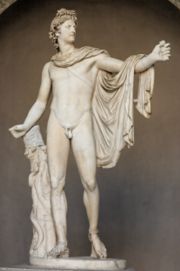 Apollo Belvedere (Pythian Apollo). Roman copy of a Greek bronze—original c. 350 BC, by Leochares. Vatican Museum
Apollo Belvedere (Pythian Apollo). Roman copy of a Greek bronze—original c. 350 BC, by Leochares. Vatican Museum
In his role as god of prophecy and truth, Apollo had the epithets Manticus (/ˈmæntɨkəs/ man-ti-kəs; Μαντικός, Mantikos, literally "prophetic"), Leschenorius (/ˌlɛskɨˈnɔəriəs/ les-ki-nohr-ee-əs; Λεσχηνόριος, Leskhēnorios, from λεσχήνωρ, "converser"), and Loxias (/ˈlɒksiəs/ lok-see-əs; Λοξίας, Loxias, from λέγειν, "to say").[14] The epithet "Loxias" has historically been associated with λοξός, "ambiguous". In this respect, the Romans called him Coelispex (/ˈsɛlɨspɛks/ sel-i-speks; from Latin coelum, "sky", and specere, "to look at"). The epithet Iatromantis (/aɪˌætrəˈmæntɪs/ eye-at-rə-man-tis; Ἰατρομάντις, Iātromantis, from ὶατρός, "physician", and μάντις, "prophet") refers to both his role as a god of healing and of prophecy. As god of music and arts, Apollo had the epithet Musagetes (/mjuːˈsædʒɨtiːz/ mew-saj-i-teez; Doric Μουσαγέτας, Mousāgetās)[21] or Musegetes (/mjuːˈsɛdʒɨtiːz/ mew-sej-i-teez; Μουσηγέτης, Mousēgetēs, from Μούσα, "Muse", and ἡγέτης, "leader").
As a god of archery, Apollo was known as Aphetor (/əˈfiːtər/ ə-fee-tər; Ἀφήτωρ, Aphētōr, from ὰφίημι, "to let loose") or Aphetorus (/əˈfɛtərəs/ ə-fet-ər-əs; Ἀφητόρος, Aphētoros, of the same origin), Argyrotoxus (/ˌɑrdʒɨrəˈtɒksəs/ ar-ji-rə-tok-səs; Ἀργυρότοξος, Argurotoxos, literally "with silver bow"), Hecaërgus (/ˌhɛkiˈɜrɡəs/ hek-ee-ur-gəs; Ἑκάεργος, Hekaergos, literally "far-shooting"), and Hecebolus (/hɨˈsɛbələs/ hi-seb-ə-ləs; Ἑκηβόλος, Hekēbolos, literally "far-shooting"). The Romans referred to Apollo as Articenens (/ɑrˈtɪsɨnənz/ ar-tiss-i-nənz; "bow-carrying"). Apollo was called Ismenius (/ɪzˈmiːniəs/ iz-mee-nee-əs; Ἰσμηνιός, Ismēnios, literally "of Ismenus") after Ismenus, the son of Amphion and Niobe, whom he struck with an arrow.
Celtic epithets and cult titles
Apollo was worshipped throughout the Roman Empire. In the traditionally Celtic lands he was most often seen as a healing and sun god. He was often equated with Celtic gods of similar character.[22]
- Apollo Atepomarus ("the great horseman" or "possessing a great horse"). Apollo was worshipped at Mauvières (Indre). Horses were, in the Celtic world, closely linked to the sun.[23]
- Apollo Belenus ('bright' or 'brilliant'). This epithet was given to Apollo in parts of Gaul, Northern Italy and Noricum (part of modern Austria). Apollo Belenus was a healing and sun god.[24]
- Apollo Cunomaglus ('hound lord'). A title given to Apollo at a shrine in Wiltshire. Apollo Cunomaglus may have been a god of healing. Cunomaglus himself may originally have been an independent healing god.[25]
- Apollo Maponus. A god known from inscriptions in Britain. This may be a local fusion of Apollo and Maponus.
- Apollo Moritasgus ('masses of sea water'). An epithet for Apollo at Alesia, where he was worshipped as god of healing and, possibly, of physicians.[29]
- Apollo Vindonnus ('clear light'). Apollo Vindonnus had a temple at Essarois, near Châtillon-sur-Seine in Burgundy. He was a god of healing, especially of the eyes.[27]
- Apollo Virotutis ('benefactor of mankind?'). Apollo Virotutis was worshipped, among other places, at Fins d'Annecy (Haute-Savoie) and at Jublains (Maine-et-Loire).[28][30]
Origins
 The Omphalos in the Museum of Delphi
The Omphalos in the Museum of Delphi
The cult centers of Apollo in Greece, Delphi and Delos, date from the 8th century BCE. The Delos sanctuary was primarily dedicated to Artemis, Apollo's twin sister. At Delphi, Apollo was venerated as the slayer of Pytho. For the Greeks, Apollo was all the Gods in one and through the centuries he acquired different functions which could originate from different gods. In archaic Greece he was the "prophet", the oracular god who in older times was connected with "healing". In classical Greece he was the god of light and of music, but in popular religion he had a strong function to keep away evil.[31] Walter Burkert[32] discerned three components in the prehistory of Apollo worship, which he termed "a Dorian-northwest Greek component, a Cretan-Minoan component, and a Syro-Hittite component."
From his eastern-origin Apollo brought the art of inspection from "symbols and omina" ( σημεία και τέρατα : simia ke terata ), and of the observation of the omens of the days. The inspiration oracular-cult was probably introduced from Anatolia. The ritualism belonged to Apollo from the beginning. The Greeks created the legalism, the supervision of the orders of the gods, and the demand for moderation and harmony. Apollo became the god of shining youth, the protector of music, spiritual-life, moderation and perceptible order. The improvement of the old Anatolian god, and his elevation to an intellectual sphere, may be considered an achievement of the Greek people. [33]
Healer god-Protector from evil
The function of Apollo as a "healer" is connected with Paean (Παιών-Παιήων), the physician of the Gods in the Iliad, who seems to come from a more primitive religion. Paeοn is probably connected with the Mycenean Pa-ja-wo, but the etymology is the only evidence. He did not have a separate cult, but he was the personification of the holy magic-song sung by the magicians that was supposed to cure disease. Later the Greeks knew the original meaning of the relevant song "paeαn" (παιάν). The magicians were also called "seer-doctors" (ιατρομάντεις), and they used an ecstatic prophetic art which was used exactly by the god Apollo at the oracles.[34] In Ilias, Apollo is the healer under the gods, but he is also the bringer of disease and death with his arrows, similar to the function of the terrible Vedic god of disease Rudra. [35] He sends a terrible plague (λοιμός) to the Achaeans. The god who sends a disease can also prevent from it, therefore when it stops they make a purifying ceremony and offer him an "hecatomb" to ward off evil. When the oath of his priest appeases, they pray and with a song they call their own god, the beautiful Paean.[36] Some common epithets of Apollo as a healer are "paion" (παιών:touching), "epikourios" (επικουρώ:help), "oulios" (ουλή:cured wound), and "loimios" (λοiμός:plague). In classical times, his strong function in popular religion was to keep away evil, and was therefore called "apotropaios" (αποτρέπω:to divert) and "alexikakos" (αλέξω-κακό:defend, throw away the evil).[37] In later writers, the word, usually spelled "Paean", becomes a mere epithet of Apollo in his capacity as a god of healing.[38]
Homer illustrated Paeon the god, and the song both of apotropaic thanksgiving or triumph.[39][citation needed] Such songs were originally addressed to Apollo, and afterwards to other gods: to Dionysus, to Apollo Helios, to Apollo's son Asclepius the healer. About the 4th century BCE, the paean became merely a formula of adulation; its object was either to implore protection against disease and misfortune, or to offer thanks after such protection had been rendered. It was in this way that Apollo had become recognised as the god of music. Apollo's role as the slayer of the Python led to his association with battle and victory; hence it became the Roman custom for a paean to be sung by an army on the march and before entering into battle, when a fleet left the harbour, and also after a victory had been won
Dorian origin
The connection with Dorians and their initiation festival apellai is reinforced by the month Apellaios in northwest Greek calendars,[40] but it can explain only the Doric type of the name, which is connected with the Ancient Macedonian word "pella" (Pella), stone. Stones played an important part in the cult of the god, especially in the oracular shrine of Delphi (Omphalos).[41][42] The "Homeric hymn" represents Apollo as a Northern intruder. His arrival must have occurred during the "dark ages" that followed the destruction of the Mycenaean civilization, and his conflict with Gaia (Mother Earth) was represented by the legend of his slaying her daughter the serpent Python.[43]
The earth deity had power over the ghostly world, and it is believed that she was the deity behind the oracle.[44] The older tales mentioned two dragons who were perhaps intentionally conflated. A female dragon named Delphyne (δελφύς:womb), who is obviously connected with Delphi and Apollo Delphinios, and a male serpent Typhon (τύφειν:smoke), the adversary of Zeus in the Titanomachy, who the narrators confused with Python.[45][46] Python was the good daemon (αγαθός δαίμων) of the temple as it appears in Minoan religion,[47] but she was represented as a dragon, as often happens in Northern European folklore as well as in the East.[48]
Apollo and his sister Artemis can bring death with their arrows. The conception that diseases and death come from invisible shots sent by supernatural beings, or magicians is common in Germanic and Norse mythology. [49] In Greek mythology Artemis was the leader ( ηγεμόνη : hegemone) of the nymphs , who had similar functions with the Nordig Elves. [50]The "elf-shot" originally indicated disease or death attributed to the elves, but it was later attested denoting arrow-heads which were used by witches, to harm people. [51] The Vedic Rudra has some similar functions with Apollo. The terrible god is called "The Archer" , and the arch is also an attribute of Shiba. [52] Rudra could bring diseases with his arrows, but he was able to free people of them, and his alternative Shiba, is a healer physician god. [53] . However the IE component of Apollo, does not explain his strong relation with omens, exorcisms , and with the oracular cult.
Minoan origin
It seems an oracular cult existed in Delphi from the Mycenaean ages.[54] In historical times, the priests of Delphi were called Labryaden, "the double-axe men", which indicates Minoan origin. The double-axe (λάβρυς:labrys) was the holy symbol of the Cretan labyrinth.[55][56] The Homeric hymn adds that Apollo appeared as a dolphin and carried Cretan priests to Delphi, where they evidently transferred they religious practices. Apollo Delphinios was a sea-god especially worshiped in Crete and in the islands, and his name indicates his connection with Delphi [57] and the holy serpent Delphyne (womb). Apollo’s sister Artemis, who was the Greek goddess of hunting, is identified with Britomartis (Diktynna), the Minoan "Mistress of the animals". In his earliest depictions she is accompanied by the "Mister of the animals", a male god of hunting who had the bow as his attribute. We don’t know his original name, but it seems that he was absorbed by the more powerful Apollo, who stood by the "Mistress of the animals", becoming her brother. [50].
The old oracles in Delphi seem to be connected with a local tradition of the priesthood, and there is not clear evidence that a kind of inspiration-prophecy existed in the temple. This led some scholars to the conclusion that Pythia carried on the rituals in a consistent procedure through many centuries, according to the local tradition. In that regard, the mythical seeress Sibyl of Anatolian origin, with her ecstatic art, looks unrelated to the oracle itself.[58] However, the Greek tradition is referring to the existence of vapours and chewing of laurel-leaves, which seem to be confirmed by recent studies.[59] Plato describes the priestesses of Delphi and Dodona as frenzied women, obsessed by "mania" (μανία:frenzy), a Greek word connected with "mantis" (μάντις:prophet). Frenzied women like Sibyls from whose lips the god speaks are recorded in the Near East as Mari in the second millennium BC.[60] Although Crete had contacts with Mari from 2000 BC,[61] there is no evidence that the ecstatic prophetic art existed during the Minoan and Mycenean ages. It is more probable that this art was introduced later from Anatolia and regenerated an existing oracular cult that was local to Delphi and dormant in several areas of Greece.[62]
Anatolian origin
 Illustration of a coin of Apollo Agyieus from Ambracia
Illustration of a coin of Apollo Agyieus from Ambracia
A non-Greek origin of Apollo has long been assumed in scholarship.[3] The name of Apollo’s mother Leto has Lydian origin, and she was worshipped on the coasts of Asia Minor. The inspiration oracular cult was probably introduced into Greece from Anatolia, which is the origin of Sibyl, and where existed some of the oldest oracular shrines. Omens, symbols, purifications, and exorcisms appear in old Assyrian-Babylonian texts, and these rituals were spread into the empire of the Hittites. In a Hittitic text is mentioned that the king invited a Babylonian priestess for a certain "purification". [33] A similar story is mentioned by Plutarch. He writes that the Cretan- seer Epimenides purified Athens after the pollution brought by the Alcmeonidae, and that the seer's expertise in sacrifices and reform of funeral practices were of great help to Solon in his reform of the Athenian state. [63] The story indicates that Epimenides was probably heir to the shamanic religions of Asia, and proves together with the Homeric hymn, that Crete had a resisting religion up to the historical times. It seems that these rituals were dormant in Greece, and they were reinforced when the Greeks migrated to Anatolia.
Homer pictures Apollo on the side of the Trojans, fighting against the Achaeans, during the Trojan War. He is pictured as a terrible god, less trusted by the Greeks than other gods. The god seems to be related to Appaliunas, a tutelary god of Wilusa in Asia Minor, but the word is not complete.[64] The stones found in front of the gates of Homeric Troy were the symbols of Apollo. The Greeks gave to him the name αγυιεύς agyieus as the protector god of public places and houses who wards off evil, and his symbol was a tapered stone or column.[65] However, while usually Greek festivals were celebrated at the full moon, all the feasts of Apollo were celebrated at the seventh day of the month, and the emphasis given to that day (sibutu) indicates a Babylonian origin.[66]
The Late Bronze Age (from 1700 to 1200 BCE) Hittite and Hurrian Aplu was a god of plague, invoked during plague years. Here we have an apotropaic situation, where a god originally bringing the plague was invoked to end it. Aplu, meaning the son of, was a title given to the god Nergal, who was linked to the Babylonian god of the sun Shamash.[12] Homer interprets Apollo as a terrible god (δεινός θεός) who brings death and disease with his arrows, but who can also heal, possessing a magic art that separates him from the other Greek gods.[67] In Ilias, his priest prays to Apollo Smintheus,[68] the mouse god who retains an older agricultural function as the protector from field rats.[69][70] All these functions, including the function of the healer-god Paean, who seems to have Mycenean origin, are fused in the cult of Apollo.
Oracular cult
Unusually among the Olympic deities, Apollo had two cult sites that had widespread influence: Delos and Delphi. In cult practice, Delian Apollo and Pythian Apollo (the Apollo of Delphi) were so distinct that they might both have shrines in the same locality.[71] Apollo's cult was already fully established when written sources commenced, about 650 BCE. Apollo became extremely important to the Greek world as an oracular deity in the archaic period, and the frequency of theophoric names such as Apollodorus or Apollonios and cities named Apollonia testify to his popularity. Oracular sanctuaries to Apollo were established in other sites. In the 2nd and 3rd century CE, those at Didyma and Clarus pronounced the so-called "theological oracles", in which Apollo confirms that all deities are aspects or servants of an all-encompassing, highest deity. "In the 3rd century, Apollo fell silent. Julian the Apostate (359 - 61) tried to revive the Delphic oracle, but failed."[3]
Oracular shrines
Apollo had a famous oracle in Delphi, and other notable ones in Clarus and Branchidae. His oracular shrine in Abae in Phocis, where he bore the toponymic epithet Abaeus (Ἀπόλλων Ἀβαῖος, Apollon Abaios) was important enough to be consulted by Croesus (Herodotus, 1.46). His oracular shrines include:
- Abae in Phocis
- Bassae in the Peloponnese
- At Clarus, on the west coast of Asia Minor; as at Delphi a holy spring which gave off a pneuma, from which the priests drank.
- In Corinth, the Oracle of Corinth came from the town of Tenea, from prisoners supposedly taken in the Trojan War.
- At Khyrse, in Troad, the temple was built for Apollon Smintheus
- In Delos, there was an oracle to the Delian Apollo, during summer. The Hieron (Sanctuary) of Apollo adjacent to the Sacred Lake, was the place where the god was said to have been born.
- In Delphi, the Pythia became filled with the pneuma of Apollo, said to come from a spring inside the Adyton.
- In Didyma, an oracle on the coast of Anatolia, south west of Lydian (Luwian) Sardis, in which priests from the lineage of the Branchidae received inspiration by drinking from a healing spring located in the temple. Was believed to have been founded by Branchus, son or lover of Apollo.
- In Hierapolis Bambyce, Syria (modern Manbij), according to the treatise De Dea Syria, the sanctuary of the Syrian Goddess contained a robed and bearded image of Apollo. Divination was based on spontaneous movements of this image.[72]
- At Patara, in Lycia, there was a seasonal winter oracle of Apollo, said to have been the place where the god went from Delos. As at Delphi the oracle at Patara was a woman.
- In Segesta in Sicily
Oracles were also given by sons of Apollo.
- In Oropus, north of Athens, the oracle Amphiaraus, was said to be the son of Apollo; Oropus also had a sacred spring.
- in Labadea, 20 miles (32 km) east of Delphi, Trophonius, another son of Apollo, killed his brother and fled to the cave where he was also afterwards consulted as an oracle
Mythology
Birth
When Zeus' wife Hera discovered that Leto was pregnant and that Zeus was the father, she banned Leto from giving birth on "terra firma". In her wanderings, Leto found the newly created floating island of Delos, which was neither mainland nor a real island, so she gave birth there, where she was accepted by the people, offering them her promise that her son will be always favourable toward the city. Afterwards, Zeus secured Delos to the bottom of the ocean. This island later became sacred to Apollo.
It is also stated that Hera kidnapped Ilithyia, the goddess of childbirth, to prevent Leto from going into labor. The other gods tricked Hera into letting her go by offering her a necklace, nine yards (8 m) long, of amber. Mythographers agree that Artemis was born first and then assisted with the birth of Apollo, or that Artemis was born one day before Apollo, on the island of Ortygia and that she helped Leto cross the sea to Delos the next day to give birth to Apollo. Apollo was born on the seventh day (ἑβδομαγενής)[73] of the month Thargelion —according to Delian tradition—or of the month Bysios—according to Delphian tradition. The seventh and twentieth, the days of the new and full moon, were ever afterwards held sacred to him.
Youth
Four days after his birth, Apollo killed the chthonic dragon Python, which lived in Delphi beside the Castalian Spring. This was the spring which emitted vapors that caused the oracle at Delphi to give her prophecies. Hera sent the serpent to hunt Leto to her death across the world. To protect his mother, Apollo begged Hephaestus for a bow and arrows. After receiving them, Apollo cornered Python in the sacred cave at Delphi.[74] Apollo killed Python but had to be punished for it, since Python was a child of Gaia.
Hera then sent the giant Tityos to kill Leto. This time Apollo was aided by his sister Artemis in protecting their mother. During the battle Zeus finally relented his aid and hurled Tityos down to Tartarus. There he was pegged to the rock floor, covering an area of 9 acres (36,000 m2), where a pair of vultures feasted daily on his liver.
Trojan War
Apollo shot arrows infected with the plague into the Greek encampment during the Trojan War in retribution for Agamemnon's insult to Chryses, a priest of Apollo whose daughter Chryseis had been captured. He demanded her return, and the Achaeans complied, indirectly causing the anger of Achilles, which is the theme of the Iliad.
In the Iliad, when Diomedes injured Aeneas, Apollo rescued him. First, Aphrodite tried to rescue Aeneas but Diomedes injured her as well. Aeneas was then enveloped in a cloud by Apollo, who took him to Pergamos, a sacred spot in Troy.
Apollo aided Paris in the killing of Achilles by guiding the arrow of his bow into Achilles' heel. One interpretation of his motive is that it was in revenge for Achilles' sacrilege in murdering Troilus, the god's own son by Hecuba, on the very altar of the god's own temple.
Admetus
When Zeus struck down Apollo's son Asclepius with a lightning bolt for resurrecting Hippolytus from the dead (transgressing Themis by stealing Hades's subjects), Apollo in revenge killed the Cyclopes, who had fashioned the bolt for Zeus.[75] Apollo would have been banished to Tartarus forever, but was instead sentenced to one year of hard labor as punishment, due to the intercession of his mother, Leto. During this time he served as shepherd for King Admetus of Pherae in Thessaly. Admetus treated Apollo well, and, in return, the god conferred great benefits on Admetus.
Apollo helped Admetus win Alcestis, the daughter of King Pelias and later convinced the Fates to let Admetus live past his time, if another took his place. But when it came time for Admetus to die, his parents, whom he had assumed would gladly die for him, refused to cooperate. Instead, Alcestis took his place, but Heracles managed to "persuade" Thanatos, the god of death, to return her to the world of the living.
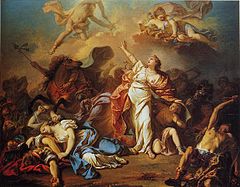 Artemis and Apollo Piercing Niobe’s Children with their Arrows by Jacques-Louis David. Dallas Museum of Art
Artemis and Apollo Piercing Niobe’s Children with their Arrows by Jacques-Louis David. Dallas Museum of Art
.
Niobe
Niobe, the queen of Thebes and wife of Amphion, boasted of her superiority to Leto because she had fourteen children (Niobids), seven male and seven female, while Leto had only two. Apollo killed her sons as they practiced athletics, with the last begging for his life, and Artemis her daughters. Apollo and Artemis used poisoned arrows to kill them, though according to some versions of the myth, a number of the Niobids were spared (Chloris, usually). Amphion, at the sight of his dead sons, either killed himself or was killed by Apollo after swearing revenge. A devastated Niobe fled to Mount Sipylos in Asia Minor and turned into stone as she wept. Her tears formed the river Achelous. Zeus had turned all the people of Thebes to stone and so no one buried the Niobids until the ninth day after their death, when the gods themselves entombed them.
Consorts and children
Love affairs ascribed to Apollo are a late development in Greek mythology.[76] Their vivid anecdotal qualities have made favorites some of them of painters since the Renaissance, so that they stand out more prominently in the modern imagination.
Female lovers
Main article: Apollo and DaphneDaphne, was a nymph, daughter of the river god Peneus, who had scorned Apollo. The myth explains the connection of Apollo with δάφνη (daphnē), the laurel whose leaves his priestess employed at Delphi. [77] In Ovid's Metamorphoses , Phoebus Apollo chaffs Cupid for toying with a weapon more suited to a man, whereupon Cupid wounds him with a golden dart; simultaneously, however, Cupid shoots a leaden arrow into Daphne, causing her to be repulsed by Apollo. Following a spirited chase by Apollo, Daphne prays to her father, Peneus, for help, and he changes her into the laurel tree, sacred to Apollo. Artemis Daphnaia, who had her temple among the Lacedemonians, at a place called Hypsoi[78] in Antiquity, on the slopes of Mount Cnacadion near the Spartan frontier,[79] had her own sacred laurel trees.[80] At Eretria the identity of an excavated 7th and 6th century temple to Apollo Daphnephoros, "Apollo, laurel-bearer", or "carrying off Daphne", a "place where the citizens are to take the oath", is identified in inscriptions.[81]
Leucothea was daughter of Orchamus and sister of Clytia. She fell in love with Apollo who disguised himself as Leucothea's mother to gain entrance to her chambers. Clytia, jealous of her sister because she wanted Apollo for herself, told Orchamus the truth, betraying her sister's trust and confidence in her. Enraged, Orchamus ordered Leucothea to be buried alive. Apollo refused to forgive Clytia for betraying his beloved, and a grieving Clytia wilted and slowly died. Apollo changed her into an incense plant, either heliotrope or sunflower, which follows the sun every day.
Marpessa was kidnapped by Idas but was loved by Apollo as well. Zeus made her choose between them, and she chose Idas on the grounds that Apollo, being immortal, would tire of her when she grew old.
Castalia was a nymph whom Apollo loved. She fled from him and dove into the spring at Delphi, at the base of Mt. Parnassos, which was then named after her. Water from this spring was sacred; it was used to clean the Delphian temples and inspire the priestesses. In the last oracle is mentioned that the "water which could speak", has been lost for ever.
By Cyrene, Apollo had a son named Aristaeus, who became the patron god of cattle, fruit trees, hunting, husbandry and bee-keeping. He was also a culture-hero and taught humanity dairy skills, the use of nets and traps in hunting, and how to cultivate olives.
Hecuba, was the wife of King Priam of Troy, and Apollo had a son with her named Troilus. An oracle prophesied that Troy would not be defeated as long as Troilus reached the age of twenty alive. He was ambushed and killed by Achilleus.
Cassandra, was daughter of Hecuba and Priam, and Troilus' half-sister. Apollo fell in love with Cassandra and promised her the gift of prophecy to seduce her, but she rejected him afterwards. Enraged, Apollo indeed gifted her with the ability to know the future, with a curse that she could only see the future tragedies and that no one would ever believe her.
Coronis, was daughter of Phlegyas, King of the Lapiths. Pregnant with Asclepius, Coronis fell in love with Ischys, son of Elatus. A crow informed Apollo of the affair. When first informed he disbelieved the crow and turned all crows black (where they were previously white) as a punishment for spreading untruths. When he found out the truth he sent his sister, Artemis, to kill Coronis (in other stories, Apollo himself had killed Coronis). As a result he also made the crow sacred and gave them the task of announcing important deaths. Apollo rescued the baby and gave it to the centaur Chiron to raise. Phlegyas was irate after the death of his daughter and burned the Temple of Apollo at Delphi. Apollo then killed him for what he did.
In Euripides' play Ion, Apollo fathered Ion by Creusa, wife of Xuthus. Creusa left Ion to die in the wild, but Apollo asked Hermes to save the child and bring him to the oracle at Delphi, where he was raised by a priestess.
Acantha, was the spirit of the acanthus tree, and Apollo had one of his other liaisons with her. Upon her death, Apollo transformed her into a sun-loving herb.
According to the Biblioteca, the "library" of mythology mis-attributed to Apollodorus, he fathered the Corybantes on the Muse Thalia.[82]
Male lovers
Hyacinth or Hyacinthus was one of Apollo's male lovers. He was a Spartan prince, beautiful and athletic. The pair was practicing throwing the discus when a discus thrown by Apollo was blown off course by the jealous Zephyrus and struck Hyacinthus in the head, killing him instantly. Apollo is said to be filled with grief: out of Hyacinthus' blood, Apollo created a flower named after him as a memorial to his death, and his tears stained the flower petals with άί άί, meaning alas. The Festival of Hyacinthus was a celebration of Sparta.
Another male lover was Cyparissus, a descendant of Heracles. Apollo gave him a tame deer as a companion but Cyparissus accidentally killed it with a javelin as it lay asleep in the undergrowth. Cyparissus asked Apollo to let his tears fall forever. Apollo granted the request by turning him into the Cypress named after him, which was said to be a sad tree because the sap forms droplets like tears on the trunk.
Apollo's lyre
 Apollo with his lyre. Statue from Berlin. Pergamon Museum
Apollo with his lyre. Statue from Berlin. Pergamon Museum
Hermes was born on Mount Cyllene in Arcadia. The story is told in the Homeric Hymn to Hermes. His mother, Maia, had been secretly impregnated by Zeus. Maia wrapped the infant in blankets but Hermes escaped while she was asleep. Hermes ran to Thessaly, where Apollo was grazing his cattle. The infant Hermes stole a number of his cows and took them to a cave in the woods near Pylos, covering their tracks. In the cave, he found a tortoise and killed it, then removed the insides. He used one of the cow's intestines and the tortoise shell and made the first lyre. Apollo complained to Maia that her son had stolen his cattle, but Hermes had already replaced himself in the blankets she had wrapped him in, so Maia refused to believe Apollo's claim. Zeus intervened and, claiming to have seen the events, sided with Apollo. Hermes then began to play music on the lyre he had invented. Apollo, a god of music, fell in love with the instrument and offered to allow exchange of the cattle for the lyre. Hence, Apollo then became a master of the lyre.
Apollo in the Oresteia
In Aeschylus' Oresteia trilogy, Clytemnestra kills her husband, King Agamemnon because he had sacrificed their daughter Iphigenia to proceed forward with the Trojan war, and Cassandra, a prophetess of Apollo. Apollo gives an order through the Oracle at Delphi that Agamemnon's son, Orestes, is to kill Clytemnestra and Aegisthus, her lover. Orestes and Pylades carry out the revenge, and consequently Orestes is pursued by the Erinyes (Furies, female personifications of vengeance). Apollo and the Furies argue about whether the matricide was justified; Apollo holds that the bond of marriage is sacred and Orestes was avenging his father, whereas the Erinyes say that the bond of blood between mother and son is more meaningful than the bond of marriage. They invade his temple, and he says that the matter should be brought before Athena. Apollo promises to protect Orestes, as Orestes has become Apollo's supplicant. Apollo advocates Orestes at the trial, and ultimately Athena rules with Apollo.
Other stories
Apollo killed the Aloadae when they attempted to storm Mt. Olympus.
Callimachus sang[83] that Apollo rode on the back of a swan to the land of the Hyperboreans during the winter months.
Apollo turned Cephissus into a sea monster.
Another contender for the birthplace of Apollo is the Cretan islands of Paximadia.
Musical contests
Pan
Once Pan had the audacity to compare his music with that of Apollo, and to challenge Apollo, the god of the kithara, to a trial of skill. Tmolus, the mountain-god, was chosen to umpire. Pan blew on his pipes, and with his rustic melody gave great satisfaction to himself and his faithful follower, Midas, who happened to be present. Then Apollo struck the strings of his lyre. Tmolus at once awarded the victory to Apollo, and all but Midas agreed with the judgment. He dissented, and questioned the justice of the award. Apollo would not suffer such a depraved pair of ears any longer, and caused them to become the ears of a donkey.
Marsyas
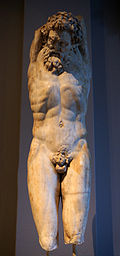 Marsyas under Apollo's punishment; İstanbul Archaeology Museum.
Marsyas under Apollo's punishment; İstanbul Archaeology Museum.
Apollo has ominous aspects aside from his plague-bringing, death-dealing arrows: Marsyas was a satyr who challenged Apollo to a contest of music. He had found an aulos on the ground, tossed away after being invented by Athena because it made her cheeks puffy. The contest was judged by the Muses. After they each performed, both were deemed equal until Apollo decreed they play and sing at the same time. As Apollo played the lyre, this was easy to do. Marsyas could not do this, as he only knew how to use the flute and could not sing at the same time. Apollo was declared the winner because of this. Apollo flayed Marsyas alive in a cave near Celaenae in Phrygia for his hubris to challenge a god. He then nailed Marsyas' shaggy skin to a nearby pine-tree. Marsyas' blood turned into the river Marsyas.
Another variation is that Apollo played his instrument (the lyre) upside down. Marsyas could not do this with his instrument (the flute), and so Apollo hung him from a tree and flayed him alive.[84]
Cinyras
Apollo also had a lyre-playing contest with Cinyras, his son, who committed suicide when he lost.
Roman Apollo
The Roman worship of Apollo was adopted from the Greeks. As a quintessentially Greek god, Apollo had no direct Roman equivalent, although later Roman poets often referred to him as Phoebus.[85] There was a tradition that the Delphic oracle was consulted as early as the period of the kings of Rome during the reign of Tarquinius Superbus.[86] On the occasion of a pestilence in the 430s BCE, Apollo's first temple at Rome was established in the Flaminian fields, replacing an older cult site there known as the "Apollinare".[87] During the Second Punic War in 212 BCE, the Ludi Apollinares ("Apollonian Games") were instituted in his honor, on the instructions of a prophecy attributed to one Marcius.[88] In the time of Augustus, who considered himself under the special protection of Apollo and was even said to be his son, his worship developed and he became one of the chief gods of Rome.[89] After the battle of Actium, which was fought near a sanctuary of Apollo, Augustus enlarged Apollo's temple, dedicated a portion of the spoils to him, and instituted quinquennial games in his honour.[90] He also erected a new temple to the god on the Palatine hill.[91] Sacrifices and prayers on the Palatine to Apollo and Diana formed the culmination of the Secular Games, held in 17 BCE to celebrate the dawn of a new era.[92]
Festivals
The chief Apollonian festivals were the Boedromia, Carneia, Carpiae, Daphnephoria, Delia, Hyacinthia, Metageitnia, Pyanepsia, Pythia and Thargelia.
Attributes and symbols
 Gold stater of the Seleucid king Antiochus I Soter (reigned 281–261 BCE) showing on the reverse a nude Apollo holding his key attributes: two arrows and leaning on a bow.
Gold stater of the Seleucid king Antiochus I Soter (reigned 281–261 BCE) showing on the reverse a nude Apollo holding his key attributes: two arrows and leaning on a bow.
Apollo's most common attributes were the bow and arrow. Other attributes of his included the kithara (an advanced version of the common lyre), the plectrum and the sword. Another common emblem was the sacrificial tripod, representing his prophetic powers. The Pythian Games were held in Apollo's honor every four years at Delphi. The bay laurel plant was used in expiatory sacrifices and in making the crown of victory at these games. The palm was also sacred to Apollo because he had been born under one in Delos. Animals sacred to Apollo included wolves, dolphins, roe deer, swans, cicadas (symbolizing music and song), hawks, ravens, crows, snakes (referencing Apollo's function as the god of prophecy), mice and griffins, mythical eagle–lion hybrids of Eastern origin.
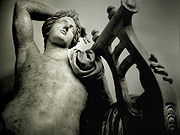 Apollo Citharoedus ("Apollo with a kithara"), Musei Capitolini, Rome
Apollo Citharoedus ("Apollo with a kithara"), Musei Capitolini, Rome
As god of colonization, Apollo gave oracular guidance on colonies, especially during the height of colonization, 750–550 BCE. According to Greek tradition, he helped Cretan or Arcadian colonists found the city of Troy. However, this story may reflect a cultural influence which had the reverse direction: Hittite cuneiform texts mention a Minor Asian god called Appaliunas or Apalunas in connection with the city of Wilusa attested in Hittite inscriptions, which is now generally regarded as being identical with the Greek Ilion by most scholars. In this interpretation, Apollo's title of Lykegenes can simply be read as "born in Lycia", which effectively severs the god's supposed link with wolves (possibly a folk etymology).
In literary contexts, Apollo represents harmony, order, and reason—characteristics contrasted with those of Dionysus, god of wine, who represents ecstasy and disorder. The contrast between the roles of these gods is reflected in the adjectives Apollonian and Dionysian. However, the Greeks thought of the two qualities as complementary: the two gods are brothers, and when Apollo at winter left for Hyperborea, he would leave the Delphic oracle to Dionysus. This contrast appears to be shown on the two sides of the Borghese Vase.
Apollo is often associated with the Golden Mean. This is the Greek ideal of moderation and a virtue that opposes gluttony.
Apollo in the arts
Apollo is a common theme in Greek and Roman art and also in the art of the Renaissance. The earliest Greek word for a statue is "delight" (άγαλμα: agalma), and the sculptors tried to create forms which would inspire such guiding vision. Greek art puts into Apollo the highest degree of power and beauty that can be imagined. The sculptors derived this from observations on human beings, but they also embodied in concrete form, issues beyond the reach of ordinary thought. The naked bodies of the statues are associated with the cult of the body that was essentially a religious activity. The muscular frames and limbs combined with slim waists indicate the Greek desire for health, and the physical capacity which was necessary in the hard Greek environment. The statues of Apollo embody beauty, balance and inspire awe before the beauty of the world.
The evolution of the Greek sculpture can be observed in his depictions from the almost static formal Kouros type in early archaic period, to the representation of motion in a relative harmonious whole in late archaic period. In classical Greece the emphasis is not given to the illusive imaginative reality represented by the ideal forms, but to the analogies and the interaction of the members in the whole, a method created by Polykleitos. Finally Praxiteles seems to be released from any art and religious conformities, and his masterpieces are a mixture of naturalism with stylization.
Art and Greek philosophy
The evolution of the Greek art seems to go parallel with the Greek philosophical conceptions, which changed from the natural-philosophy of Thales to the metaphysical theory of Pythagoras. Thales searched for a simple material-form directly perceptible by the senses, behind the appearances of things, and his theory is also related to the older animism. This was paralleled in sculpture by the absolute representation of vigorous life, through unnaturally simplified forms.[93] Pythagoras believed that behind the appearance of things, there was the permanent principle of mathematics, and that the forms were based on a transcendental mathematical relation.[94] The forms on earth, are imperfect imitations ( εικών, ikon :image) of the celestial world of numbers. His ideas had a great influence on post-Archaic art, and the Greek architects and sculptors were always trying to find the mathematical relation, that would lead to the esthetic perfection.[95] (canon). Finally in classical Greece Anaxagoras asserted that a divine reason (mind) gave order to the seeds of the universe, and Plato extended the Greek belief of ideal forms to his metaphysical theory of forms (ideai: ideas). The Greek words "ida" ( οίδα:know) and "idos" (είδος:species) have the same root as the word "idea" (ιδέα),[95] indicating how the Greek mind moved from the gift of the senses, to the principles beyond the senses. However the artists in Plato's time moved away from his theories and art tends to be a mixture of naturalism with stylization. The Greek sculptors considered the senses more important, and the proportions were used to unite the sensible with the intellectual.
Archaic sculpture
 Sacred Gate Kouros. Marble (610–600 BC). Kerameikos Archaeological Museum in Athens
Sacred Gate Kouros. Marble (610–600 BC). Kerameikos Archaeological Museum in Athens
Kouros (male youth) is the modern term given to those representations of standing male youths which first appear in the archaic period in Greece. This type served certain religious needs and was first proposed for what was previously thought to be depictions of Apollo.[96][97] The first statues are certainly still and formal. The formality of their stance seems to be related with the Egyptian precedent, but it was accepted for a good reason. The sculptors had a clear idea of what a young man is, and embodied the archaic smile of good manners, the firm and springy step, the balance of the body, dignity, and youthful happiness. When they tried to depict the most abiding qualities of men, it was because men had common roots with the unchanging gods. .[98] The adoption of a standard recognizable type for a long time, is probably because nature gives preference in survival of a type which has long be adopted by the climatic conditions, and also due to the general Greek belief that nature expresses itself in ideal forms that can be imagined and represented.[95] These forms expressed immortality. Apollo was the immortal god of ideal balance and order; his shrine in Delphi has the inscription: "Nothing in excess".
In the first large-scale depictions during the early archaic period (640–580 BC), the artists tried to draw one's attention to look into the interior of the face and the body which were not represented as lifeless masses, but as being full of life. The Greeks maintained, until late in their civilization, an almost animistic idea that the statues are in some sense alive. This embodies the belief that the image was somehow the god or man himself.[99] A fine example is the statue of the Sacred gate Kouros which was found at the cemetery of Dipylon in Athens (Dipylon Kouros). The statue is the "thing in itself", and his slender face with the deep eyes express an intellectual eternity. According to the Greek tradition the Dipylon master was named Daedalus, and in his statues the limbs were freed from the body, giving the impression that the statues could move. It is considered that he created also the New York kouros, which is the oldest fully preserved statue of Kouros type, and seems to be the incarnation of the god himself.[93] The animistic idea as the representation of the imaginative reality, is sanctified in the Homeric poems and in Greek myths, in stories of the god Hephaestus (Phaistos) and the mythic Daedalus (the builder of the labyrinth) that made images which moved of their own accord. This kind of art goes back to the Minoan period, when its main theme was the representation of motion in a specific moment.[100] These free-standing statues were usually marble, but also the form rendered in limestone, bronze, ivory and terracotta.
The earliest examples of life-sized statues of Apollo, may be two figures from the Ionic sanctuary on the island of Delos. Such statues were found across the Greek speaking world, the preponderance of these were found at the sanctuaries of Apollo with more than one hundred from the sanctuary of Apollo Ptoios, Boeotia alone.[101] The last stage in the development of the Kouros type is the late archaic period (520–485 BC), in which the Greek sculpture attained a full knowledge of human anatomy and used to create a relative harmonious whole. Ranking from the very few bronzes survived to us is the masterpiece bronze Piraeus Apollo. It was found in Piraeus, the harbour of Athens. The statue originally held the bow in its left hand, and a cup of pouring libation in its right hand. It probably comes from north=eastern Peloponesus. The emphasis is given in anatomy, and it is one of the first attempts to represent a kind of motion, and beauty relative to proportions, which appear mostly in post-Archaic art. The statue throws some light on an artistic centre which, with an independently developed harder, simpler, and heavier style, restricts Ionian influence in Athens. Finally, this is the germ from which the art of Polykleitos was to grow two or three generations later.[102]
Classical Sculpture
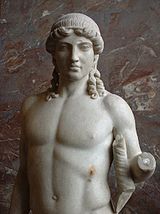 Apollo of the Mantoua type. Marble Roman copy after a 5th-century BC Greek original attributed to Polykleitos. Louvre
Apollo of the Mantoua type. Marble Roman copy after a 5th-century BC Greek original attributed to Polykleitos. Louvre
In the next century which is the beginning of the Classical period, it was considered that beauty in visible things as in everything else, consisted of symmetry and proportions. The artists tried also to represent motion in a specific moment (Myron), which may be considered as the reappearance of the dormant Minoan element.[100] Anatomy and geometry are fused in one, and each does something to the other. The Greek sculptors tried to clarify it by looking for mathematical proportions, just as they sought some reality behind appearances. Polykleitos in his Canon wrote that beauty consists in the proportion not of the elements ( materials), but of the parts, that is the interrelation of parts with one another and with the whole. It seems that he was influenced by the theories of Pythagoras. [103] The famous Apollo of Mantua and its variants are early forms of the Apollo Citharoedus statue type, in which the god holds the cithara in his left arm. The type is represented by neo-Attic Imperial Roman copies of the late 1st or early 2nd century, modelled upon a supposed Greek bronze original made in the second quarter of the 5th century BCE, in a style similar to works of Polykleitos but more archaic. The Apollo held the cythara against his extended left arm, of which in the Louvre example, a fragment of one twisting scrolling horn upright remains against his biceps.
Though the proportions were always important in Greek art, the appeal of the Greek sculptures eludes any explanation by proportion alone. The statues of Apollo were thought to incarnate his living presence, and these representations of illusive imaginative reality had deep roots in the Minoan period, and in the beliefs of the first Greek speaking people who entered the region during the bronze-age. Just as the Greeks saw the mountains, forests, sea and rivers as inhabited by concrete beings, so nature in all of its manifestations possesses clear form, and the form of a work of art. Spiritual life is incorporated in matter, when it is given artistic form. Just as in the arts the Greeks sought some reality behind appearances, so in mathematics they sought permanent principles which could be applied wherever the conditions were the same. Artists and sculptors tried to find this ideal order in relation with mathematics, but they believed that this ideal order revealed itself not so much to the dispassionate intellect, as to the whole sentient self.[93] Things as we see them, and as they really are, are one, that each stresses the nature of the other in a single unity.
Pediments and Friezes
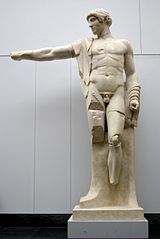 Apollo, West Pediment Olympia. Munich, copy from original, 460 BC at the Temple of Zeus, Olympia, Greece
Apollo, West Pediment Olympia. Munich, copy from original, 460 BC at the Temple of Zeus, Olympia, Greece
In the archaic pediments and friezes of the temples, the artists had a problem to fit a group of figures into an isosceles triangle with acute angles at the base. The Siphnian Treasury in Delphi was one of the first Greek buildings utilizing the solution to put the dominating form in the middle, and to complete the descending scale of height with other figures sitting or kneeling. The pediment shows the story of Herakles stealing Apollo's tripod that was strongly associated with his oracular inspiration. Their two figures hold the centre. In the pediment of the temple of Zeus in Olympia, the single figure of Apollo is dominating the scene.[98] These representations rely on presenting scenes directly to the eye for their own visible sake. They care for the schematic arrangements of bodies in space, but only as parts in a larger whole. While each scene has its own character and completeness it must fit into the general sequence to which it belongs. In these archaic pediments the sculptors use empty intervals, to suggest a passage to and fro a busy battlefield. The artists seem to have been dominated by geometrical pattern and order, and this was improved when classical art brought a greater freedom and economy.[98]
Hellenistic Greece-Rome
Apollo as a handsome beardless young man, is often depicted with a kithara (as Apollo Citharoedus) or bow in his hand, or reclining on a tree (the Apollo Lykeios and Apollo Sauroctonos types). The Apollo Belvedere is a marble sculpture that was rediscovered in the late 15th century; for centuries it epitomized the ideals of Classical Antiquity for Europeans, from the Renaissance through the 19th century. The marble is a Hellenistic or Roman copy of a bronze original by the Greek sculptor Leochares, made between 350 and 325 BCE.
The life-size so-called "Adonis" found in 1780 on the site of a villa suburbana near the Via Labicana in the Roman suburb of Centocelle is identified as an Apollo by modern scholars. In the late 2nd century CE floor mosaic from El Djem, Roman Thysdrus, he is identifiable as Apollo Helios by his effulgent halo, though now even a god's divine nakedness is concealed by his cloak, a mark of increasing conventions of modesty in the later Empire.
Another haloed Apollo in mosaic, from Hadrumentum, is in the museum at Sousse.[104] The conventions of this representation, head tilted, lips slightly parted, large-eyed, curling hair cut in locks grazing the neck, were developed in the 3rd century BCE to depict Alexander the Great (Bieber 1964, Yalouris 1980). Some time after this mosaic was executed, the earliest depictions of Christ would also be beardless and haloed.
Modern reception
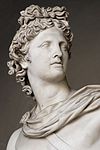 Detail. Head of Apollo Belvedere (Pythian Apollo). Vatican Museum
Detail. Head of Apollo Belvedere (Pythian Apollo). Vatican Museum
Apollo has often featured in postclassical art and literature. Percy Bysshe Shelley composed a "Hymn of Apollo" (1820), and the god's instruction of the Muses formed the subject of Igor Stravinsky's Apollon musagète (1927–1928). The name Apollo was given to NASA's Apollo Lunar program in the 1960s.
The statue of Apollo from the west pediment of the Temple of Zeus at Olympia (currently in the Archaeological Museum of Olympia) was depicted on the obverse of the Greek 1000 drachmas banknote of 1987–2001.[105]
In Archetypal psychology, the Apollo archetype is one of the Jungian archetypes, which according to Swiss psychiatrist Carl Jung are the innate universal psychic dispositions that form the substrate from which the basic symbols or representations of unconscious experience emerge.
Consorts and children
- Acacallis / Areia, daughter of Cleochus / Deione
- Acantha
- Aethusa
- Eleuther
- Aganippe
- Chios[109]
- Amphissa / Issa, daughter of Macareus
- Anchiale
- Oaxes[110]
- Astycome, nymph
- Eumolpus (possibly)[111]
- Arsinoe, daughter of Leucippus
- Asclepius (possibly)
- Eriopis
- Babylo
- Arabus[112]
- Bolina
- Calliope, Muse
- Cassandra
- Castalia
- Celaeno, daughter of Hyamus / Melaina / Thyia
- Chione / Philonis / Leuconoe
- Chrysorthe
- Chrysothemis
- Parthenos
- Coronis
- Coryceia
- Lycorus (Lycoreus)
- Creusa
- Cyrene
- Danais, Cretan nymph
- Daphne
- Dia, daughter of Lycaon
- Dryope
- Amphissus
- Euboea (daughter of Macareus)
- Evadne, daughter of Poseidon
- Gryne
- Hecate
- Hecuba
- Hestia (wooed her unsuccessfully)
- Hypermnestra, wife of Oicles
- Amphiaraus (possibly)
- Hypsipyle[117]
- Hyria (Thyria)
- Lycia, nymph or daughter of Xanthus
- Manto
- Marpessa
- Melia
- Othreis
- Phager
- Parnethia, nymph
- Cynnes[122]
- Parthenope
- Phthia
- Dorus
- Laodocus
- Polypoetes
- Prothoe[123]
- Procleia
- Tenes (possibly)
- Psamathe
- Linus, not the same as the singer Linus
- Rhoeo
- Rhodoessa, nymph
- Ceos, eponym of the island Ceos[124]
- Rhodope
- Sinope
- Syrus
- Stilbe
- Centaurus
- Lapithes
- Aineus
- Syllis / Hyllis
- Zeuxippus
- Thaleia, Muse / Rhetia, nymph
- The Corybantes
- Themisto, daughter of Zabius of Hyperborea[126]
- Galeotes
- Telmessus (?)
- Thero
- Chaeron
- Urania, Muse
- Linus (possibly)
- Urea, daughter of Poseidon
- Wife of Erginus
- Trophonius (possibly)
- Unknown consorts
Male lovers
- Admetus
- Branchus (alternately, a son of Apollo)
- Carnus
- Cyparissus
- Hippolytus of Sicyon (not the same as Hippolytus)
- Hymenaios
- Hyacinthus
- Iapis
- Leucates, who threw himself off a rock when Apollo attempted to carry him off[134]
See also
Notes
- ^ For the iconography of the Alexander–Helios type, see H. Hoffmann, 1963. "Helios", in Journal of the American Research Center in Egypt 2, pp. 117–23; cf. Yalouris 1980, no. 42.
- ^ Joseph Fontenrose, "Apollo and Sol in the Latin poets of the first century BC", Transactions of the American Philological Association 30 (1939), pp 439–55; "Apollo and the Sun-God in Ovid", American Journal of Philology 61 (1940) pp 429–44; and "Apollo and Sol in the Oaths of Aeneas and Latinus" Classical Philology 38.2 (April 1943), pp. 137–138.
- ^ a b c Van torn et al (Editors), Dictionary of Deities and Demons in the Bible, 1996, BRILL, pp. 73 - 76: google books preview
- ^ Behind the Name: Meaning, Origin and History of the Name Apollo
- ^ The ἁπλοῦν suggestion is repeated by Plutarch in Moralia in the sense of "unity".
- ^ Martin Nilsson, Die Geschichte der Griechische Religion, vol. I (C.H. Beck) 1955:555-564.
- ^ The reading of Apaliunas and the possible identification with Apollo is due to Emil Forrer (1931). It was doubted by Kretschmer, Glotta XXIV p.250.Martin Nilsson (1967) Vol I p.559
- ^ Latacz, Joachim, Troia und Homer: Der Weg zur Lösung eines alten Rätsels. (Munich) 2001:138.
- ^ αλέξανδρος. Henry George Lidell, Robert Scott:A Greek English Lexicon
- ^ Hans G. Güterbock, "Troy in Hittite Texts?" in: Mellink (ed.), Troy and the Trojan War: a symposium held at Bryn Mawr College, October 1984, Bryn Mawr Archaeological Monographs. Authors John Lawrence Angel, Machteld Johanna Mellink, 1986, ISBN 9780929524597, p. 42.
- ^ Edwin L. Brown, 'In Search of Anatolian Apollo' in: Chapin (ed.), Charis: essays in honor of Sara A. Immerwahr, Supplement to volume 33 of Hesperia, ASCSA, 2004, ISBN 9780876615331, p. 254.
- ^ a b de Grummond, Nancy Thomson (2006) Etruscan Myth, Sacred History, and Legend. (Philadelphia, Pennsylvania: University of Pennsylvania Museum of Archaeology and Anthropology); Mackenzie, Donald A. (2005) Myths of Babylonia and Assyria (Gutenberg)
- ^ Apollonius of Rhodes, iv. 1730; Biblioteca, i. 9. § 26
- ^ a b c d Álvaro, Jr., Santos, Allan. Simbolismo divino. Allan Álvaro, Jr., Santos. http://books.google.com/?id=uAiConL3xyYC&dq=articenens.
- ^ Aelian, On the Nature of Animals 4. 4 (A.F. Scholfield, tr.).
- ^ Ovid, Metamorphoses xiii. 715
- ^ Strabo, x. p. 451
- ^ Entry Σμινθεύς in LSJ
- ^ Euripides, Andromache 901
- ^ "Acesius". Smith's Dictionary of Greek and Roman Biography and Mythology. London, 1880.
- ^ LSJ entry Μουσαγέτας
- ^ Miranda J. Green, Dictionary of Celtic Myth and Legend, Thames and Hudson Ltd, 1997
- ^ Corpus Inscriptionum Latinarum XIII, 1863–1986; A. Ross,, Pagan Celtic Britain, 1967; M.J. Green, The Gods of the Celts, 1986, London
- ^ J. Zwicker, Fontes Historiae Religionis Celticae, 1934–36, Berlin; Corpus Inscriptionum Latinarum V, XI, XII, XIII; J. Gourcest, "Le culte de Belenos en Provence occidentale et en Gaule", Ogam 6.6 (1954:257–262); E. Thevonot, "Le cheval sacre dans la Gaule de l'Est", Revue archeologique de l'Est et du Centre-Est (vol 2), 1951; [ ], "Temoignages du culte de l'Apollon gaulois dans l'Helvetie romaine", Revue celtique (vol 51), 1934.
- ^ W.J. Wedlake, The Excavation of the Shrine of Apollo at Nettleton, Wiltshire, 1956–1971, Society of Antiquaries of London, 1982.
- ^ M. Szabo, The Celtic Heritage in Hungary, (Budapest)1971, Budapest
- ^ a b Divinites et sanctuaires de la Gaule, E. Thevonat, 1968, Paris
- ^ a b La religion des Celtes, J. de Vries, 1963, Paris
- ^ J. Le Gall, Alesia, archeologie et histoire, (Paris) 1963.
- ^ Corpus Inscriptionum Latinarum XIII
- ^ Martin Nilsson (1967)".Die Geschicte der Giechischen Religion.Vol I".C.F.Beck Verlag.Munchen. p 529
- ^ Burkert, Walter. Greek Religion, 1985:144.
- ^ a b Martin Nilsson. Die Geschichte der Griechische Religion Vol I , pp. 563-564
- ^ "επί καταπαύσει λοιμών και νόσων αδόμενος" (which is sung to stop the plagues and the diseases). Proklos: Chrestom from Photios Bibl. code. 239, p. 321: Martin Nilsson. Die Geschicthe der Griechischen religion. Vol I p.543
- ^ "The conception that the diseases come from invisible shots sent by magicians or supernatural beings is common in primitive people and also in European folklore. In North-Europe they speak of the "Elf-shots". In Sweden where the Lapps were called magicians, they speak of the "Lappen-shots". Martin Nilsson (1967).Vol I p.541
- ^ Ilias A 314. Martin Nilsson (1967). Vol I p.543
- ^ Pausanias VIII 41, 8-IV 34, 7-Sittig. Nom P. 48. f-Aristoph. Vesp. V. 61-Paus. I 3, 4. Martin Nilsson (1967) Vol I, p. 540, 544
- ^ Graf, Apollo p. 66
- ^ See Paean.
- ^ Graf, Apollo p. 104-113; Burkert also notes in this context Archilochus Fr. 94.
- ^ Compare: Baetylus. In Semetic: sacred stone
- ^ Martin Nilsson (1967). Vol I. p. 556
- ^ Herbert W. Park (1956). The delphic oracle. Vol.I, p.3
- ^ Lewis Farnel(1909)The cult of the city states. Clarendon Press. VIII pp.8-10
- ^ "Many pictures show the serpent Python living in amity with Apollo and guarding the Omphalos. Karl Kerenyi (1951). ed. 1980: The gods of the Greeks pp.36-37
- ^ "In a Pompeian fresco Python is lying peacefully on the ground and the priests with the sacred double axe in their hand bring the bull (bouphronion). Jane. H. Harisson (1912): Themis. A study of the social origins of the Greek religion. Cambridge University Press. pp. 423-424
- ^ In Minoan religion the serpent is the protector of the household (underground stored corn). Also in Greek religion, "snake of the house" (οικουρός όφις) in the temple of Athena at Acropolis, etc., and in Greek folklore. Martin Nilsson Vol.I pp.213-214
- ^ Nordig sagas. Hittite myth of Illuyankas. Also in the Bible: Leviathan. W.Porzig (1930). Illuyankas and Typhon. Kleinasiatische Forschung pp. 379-386
- ^ "The conception that the diseases come from invisible shots sent by magicians or supernatural beings is common in primitive people and also in European folklore. In North-Europe they speak of the "Elf-shots". In Sweden where the Lapps were called magicians, they speak of the "Lappen-shots". Martin Nilsson (1967).Vol I p.541
- ^ a b . Martin Nilsson (1967), Vol I, pp. 499-500
- ^ Hall, Alaric. 2005. 'Getting Shot of Elves: Healing, Witchcraft and Fairies in the Scottish Witchcraft Trials', Folklore, 116 (2005), 19-36.
- ^ For Śarva as a name of Shiva see: Apte, p. 910.
- ^ For association between Rudra and disease, with Rigvedic references, see: Bhandarkar, p. 146.
- ^ Oddysey: VIII 80,(Θ 80)
- ^ Huxley (1975).Cretan Paewones. Roman and Byzantine studies pp.129-134
- ^ H.G.Wunderlich. The secret of Creta Souvenir Press Ltd. London p. 319
- ^ Martin Nilsson (1967). Vol I p. 529
- ^ Huge Boden (2005). Classical Athens and the Delphic oracle pp. 17-18
- ^ Broad, William J. (2006). The oracle: Ancient Delphi and the science behind its lost secrets. Penguin. New York p. 32 ISBN 1 59 420081 5
- ^ Walter Burkert (1985).The Greek religion.p.116
- ^ F.Schachermeyer (1964).p.128
- ^ Martin Nilsson (1967). Vol I, pp. 543-545
- ^ Plutarch, Life of Solon, 12; Aristotle, Ath. Pol. 1
- ^ Paul Kretschmer (1936). Glotta XXIV p. 250. Martin Nilsson (1967). Vol I p. 559
- ^ Martin Nilsson, Die Geschichte der Griechische Religion. vol. I (C.H. Beck) 1955:563f.
- ^ Martin Nilsson (1967). Vol I, p. 561
- ^ Martin Nilsson (1967). Vol I. pp. 559-560
- ^ "You Apollo Smintheus, let my tears become your arrows against the Danaans, for revenge".Ilias 1.33 (A 33)
- ^ An ancient aetiological myth connects "sminthos" with mouse and suggests Cretan origin. Apollo is the mouse-god. (Strabo 13.1.48)Σμινθεύς
- ^ "Sminthia" in several areas of Greece. In Rhodes (Lindos) they belong to Apollo and Dionysos who have destroyed the rats that were swallowing the grapes". Martin Nilsson (1967). pp. 534-535
- ^ Burkert 1985:143.
- ^ Lucian (attrib.), De Dea Syria 35–37.
- ^ ἑβδομαγενής, Henry George Liddell, Robert Scott, A Greek-English Lexicon, on Perseus
- ^ Children of the Gods by Kenneth McLeish, page 32.
- ^ pseudo-Apollodorus, Bibliothke iii. 10.4.
- ^ "The love-stories themselves were not told until later." (Karl Kerenyi, The Gods of the Greeks 1951:140.
- ^ The ancient Daphne episode is noted in late narratives, notably in Ovid, Metamorphoses, in Hyginus, Fabulae, 203 and by the fourth-century-CE teacher of rhetoric and Christian convert, Libanius, in Narrationes.
- ^ G. Shipley, "The Extent of Spartan Territory in the Late Classical and Hellenistic Periods", The Annual of the British School at Athens, 2000.
- ^ Pausanias, 3.24.8 (on-line text); Lilius Gregorius Gyraldus , Historiae Deorum Gentilium, Basel, 1548, Syntagma 10, is noted in this connection in Benjamin Hederich, Gründliches mythologisches Lexikon, 1770
- ^ Karl Kerenyi, The Gods of the Greeks, 1951:141
- ^ Rufus B. Richardson, "A Temple in Eretria" The American Journal of Archaeology and of the History of the Fine Arts, 10.3 (July - September 1895:326-337); Paul Auberson, Eretria. Fouilles et Recherches I, Temple d'Apollon Daphnéphoros, Architecture (Bern, 1968). See also Plutarch, Pythian Oracle, 16.
- ^ Apollodorus, Bibliotheca, 1.3.4. Other ancient sources, however, gave the Corybantes different parents; see Sir James Frazer's note on the passage in the Bibliotheca.
- ^ Callimachus, Hymn to Apollo2.5
- ^ Man Myth and Magic by Richard Cavendish
- ^ Theoi: "KORONIS"
- ^ Livy 1.56.
- ^ Livy 3.63.7, 4.25.3.
- ^ Livy 25.12.
- ^ J. H. W. G. Liebeschuetz (1979). Continuity and Change in Roman Religion. Oxford: Oxford University Press. pp. 82–85. ISBN 0-19-814822-4.
- ^ Suetonius, Augustus 18.2; Cassius Dio 51.1.1–3.
- ^ Cassius Dio 53.1.3.
- ^ Inscriptiones Latinae Selectae 5050, translated by Mary Beard; John North and Simon Price (1998). Religions of Rome: Volume 2: A Sourcebook. Cambridge: Cambridge University Press. p. 5.7b. ISBN 0-521-45015-2 (hbk.); ISBN 0-521-45646-0 (pbk.).
- ^ a b c E.Homann-Wedeking.Transl.J.R.Foster (1968). Art of the world. Archaic Greece, Methuen & Co Ltd. London, pp 63-65, 193.
- ^ C.M. Bowra (1957). The Greek experience, p.166.
- ^ a b c R.Carpenter (1975).The esthetic basis of Greek art. Indiana University Press.p.55-58.
- ^ V.I.Leonardos(1895).Archaelogiki Ephimeris Col 75, n 1.
- ^ Lechat (1904).La sculpture Attic avant Phidias p.23
- ^ a b c C.M.Bowra (1957). The Greek experience, pp. 144-152
- ^ C.N.Bowra.The Greek experience p.159
- ^ a b F.Schachermeyer (1964). Die Minoische Kultur des alten Creta, Kohlhammer Stuttgart, pp. 242-244
- ^ J.Ducat (1971).Les Kouroi des Ptoion
- ^ Homann-Wedeking (1966). Art of the World. Archaic Greece pp. 144-150
- ^ "Each part (finger, palm, arm, etc) transmitted its individual existence to the next, and then to the whole. " : Canon of Polykleitos, also Plotinus, Ennead I vi. i : Nigel Spivey (1997). Greek art, Phaidon Press Ltd. London pp. 290-294
- ^ "http://www.tunisiaonline.com/mosaics/mosaic05b.html". http://www.tunisiaonline.com/mosaics/mosaic05b.html.
- ^ "Drachma Banknotes & Coins". Bank of Greece. Archived from the original on 2007-10-05. http://web.archive.org/web/20071005003635/http://www.bankofgreece.gr/en/banknotes/banknote_selection.asp?Value=1.000. Retrieved 2009-03-27.
- ^ Apollonius Rhodius, Argonautica, 1491 ff
- ^ Scholia on Apollonius Rhodius, Argonautica, 1491 ff
- ^ Pausanias, Description of Greece, 10. 16. 5
- ^ Pseudo-Plutarch, On Rivers, 7. 1
- ^ Servius on Virgil's Eclogue 1, 65
- ^ Photius, Lexicon, s. v. Eumolpidai
- ^ Pliny the Elder, Naturalis Historia, 7. 56 - 57 p. 196
- ^ Scholia on Apollonius Rhodius, Argonautica, 2. 498
- ^ Tzetzes on Lycophron, 77
- ^ Scholia on Apollonius Rhodius, Argonautica 4.828, referring to Hesiod' s Catalogues of Women
- ^ Tzetzes on Lycophron, 266
- ^ Arnobius, Adversus Nationes, 4. 26; not the same as Hypsipyle of Lemnos
- ^ Servius on Aeneid, 3. 332
- ^ Stephanus of Byzantium s. v. Patara
- ^ Pausanias, Description of Greece, 9. 10. 5
- ^ Pausanias, Description of Greece, 9. 26. 1
- ^ Photius, Lexicon, s. v. Kynneios
- ^ Arnobius, Adversus Nationes, 4. 26
- ^ Etymologicum Magnum 507, 54, under Keios
- ^ Etymologicum Magnum 513, 37, under Kikones
- ^ Stephanus of Byzantium, s. v. Galeōtai
- ^ Stephanus of Byzantium, s. v. Akraiphia
- ^ Scholia on Pindar, Pythian Ode 4. 181
- ^ Suda s. v. Marathōn
- ^ Stephanus of Byzantium s. v Megara
- ^ Pausanias, Description of Greece, 8. 25. 4
- ^ Stephanus of Byzantium s. v. Ogkeion
- ^ Servius on Aeneid, 10. 179
- ^ Servius on Aeneid, 3. 279
References
 This article incorporates text from a publication now in the public domain: John Henry Freese (1911). "Apollo". In Chisholm, Hugh. Encyclopædia Britannica (11th ed.). Cambridge University Press. http://en.wikisource.org/w/index.php?title=User:Tim_Starling/ScanSet_TIFF_demo&vol=02&page=EB2A196.
This article incorporates text from a publication now in the public domain: John Henry Freese (1911). "Apollo". In Chisholm, Hugh. Encyclopædia Britannica (11th ed.). Cambridge University Press. http://en.wikisource.org/w/index.php?title=User:Tim_Starling/ScanSet_TIFF_demo&vol=02&page=EB2A196.
Primary sources
- Homer, Iliad ii.595–600 (c. 700 BCE)
- Sophocles, Oedipus Rex
- Palaephatus, On Unbelievable Tales 46. Hyacinthus (330 BCE)
- Apollodorus, Library 1.3.3 (140 BCE)
- Ovid, Metamorphoses 10. 162–219 (1–8 CE)
- Pausanias, Description of Greece 3.1.3, 3.19.4 (160–176 CE)
- Philostratus the Elder, Images i.24 Hyacinthus (170–245 CE)
- Philostratus the Younger, Images 14. Hyacinthus (170–245 CE)
- Lucian, Dialogues of the Gods 14 (170 CE)
- First Vatican Mythographer, 197. Thamyris et Musae
Secondary sources
- M. Bieber, 1964. Alexander the Great in Greek and Roman Art (Chicago)
- Walter Burkert, 1985. Greek Religion (Harvard University Press) III.2.5 passim
- Graf, Fritz, Apollo, Taylor & Francis, 2009, ISBN 9780415317115.
- Robert Graves, 1960. The Greek Myths, revised edition (Penguin)
- Miranda J. Green, Dictionary of Celtic Myth and Legend, Thames and Hudson Ltd, 1997
- Karl Kerenyi, Apollon: Studien über Antiken Religion und Humanität rev. ed. 1953.
- Karl Kerenyi, 1951 The Gods of the Greeks
- Pauly–Wissowa, Realencyclopädie der klassischen Altertumswissenschaft: II, "Apollon". The best repertory of cult sites (Burkert).
- Pfeiff, K.A., 1943. Apollon: Wandlung seines Bildes in der griechischen Kunst. Traces the changing iconography of Apollo.
- Smith, William; Dictionary of Greek and Roman Biography and Mythology, London (1873). "Apollo"
External links
- Apollo at the Greek Mythology Link, by Carlos Parada
Greek religion and mythology Religions and cults Groups Twelve Olympians Other major deities Heroes Rites and practices - Amphidromia
- Hymns
- Iatromantis
- Pharmakos
- Prayers
- Sacrifices
- Temples
- Votive offerings
Sacred places Roman mythology and religion Deities Apollo · Bona Dea · Castor and Pollux · Ceres · Cupid · Diana · Dis Pater · Faunus · Genius · Hercules · Janus · Juno · Jupiter · Lares · Liber · Mars · Mercury · Minerva · Orcus · Neptune · Penates · Pluto · Priapus · Proserpina · Quirinus · Saturn · Silvanus · Sol · Venus · Vesta · Vulcan
See also List of Roman deitiesAbstract deities Legendary founders Texts Vergil, Aeneid · Ovid, Metamorphoses and Fasti · Propertius, Elegies Book 4 · Apuleius, Metamorphoses (The Golden Ass)Concepts and practices See also Categories:- Apollo
- Arts gods
- Deities in the Iliad
- Greek gods
- Greek mythology
- Health gods
- Knowledge gods
- Muses
- Mythological Greek archers
- Offspring of Zeus
- Oracular gods
- Pederastic heroes and deities
- Roman gods
- Solar gods
- Twelve Olympians
Wikimedia Foundation. 2010.


